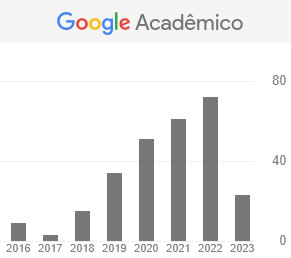Videolección regionalizada: una herramienta didáctica en el proceso de enseñanza del principio fundamental del conteo
DOI:
https://doi.org/10.5965/2357724X12222024e0109Palabras clave:
tecnologías de la información y las comunicaciones, video aula, educación matemática, análisis combinatórioResumen
Este artículo presenta un extracto de una investigación de pregrado cuyo objetivo es analizar la producción de una videolección con temas regionalizados sobre contenidos de Análisis Combinatorio, con miras a su utilización como instrumento de enseñanza dentro y fuera del aula. Esta producción es continuación del Proyecto VideoMat, del PIBID/IFPA/Campus Belém, cuyo estudio se basó en los referentes teóricos de la Etnomatemática y las Tecnologías de la Información y la Comunicación, tales como: D'Ambrósio (2002; 2009), Ponte (1995; 2000 ), Morán (1995), entre otros. Esta base teórica, con el apoyo del PIBID, permitió la producción de una videolección regionalizada de alta calidad, grabada en el principal atractivo turístico de Pará (Ver-o-peso), con lengua típica de Pará, situaciones, banda sonora, haciendo el (futuro) estudiante percibe contenidos más cercanos a su realidad, con más significado; promoviendo una mejor fijación de los temas tratados, pudiendo acceder a él tantas veces, donde y cuando quieras. Esta videolección está disponible en YouTube y puede ser utilizada tanto por profesores, como herramienta didáctica, como por estudiantes. Así, esperamos contribuir a que los profesionales de la educación puedan aprovechar este producto educativo para proporcionar una educación más cualificada, con más sentido y que les prepare para la vida en una sociedad cada vez más tecnológica.
Descargas
Citas
BRASIL. Ministério da Educação. Base Nacional Comum Curricular: proposta preliminar: terceira versão. Brasília, DF: MEC, 28 jan. 2018. Disponível em: http://basenacionalcomum.mec.gov.br/images/BNCCpublicacao.pdf. Acesso em: 15 mar. 2018.
BRASIL. Secretaria de Educação Fundamental. Parâmetros Curriculares Nacionais: terceiro e quarto ciclos do ensino fundamental: matemática. Brasília, DF: Secretaria de Educação Fundamental, 1998.
CARNEIRO, V. O educativo como entretenimento na TV cultura: Castelo Rá-Tim-Bum, um estudo de caso. 1997. Tese (Doutorado em Educação) – USP, São Paulo, 1997.
D’AMBRÓSIO, U. A matemática nas escolas. Educação Matemática em Revista, São Paulo, ano 9, p. 29-33, mar. 2002. Edição especial.
D’AMBRÓSIO, U. Educação Matemática: da teoria à prática. 17. ed. Campinas. Papirus, 2009.
FERNANDES, M. B. M. O Pará que «Treme»: Compreendendo o Tecnobrega como Património Cultural Imaterial. CEM Cultura, Espaço & Memória, [s. l.], n. 11, p. 284-293. 2021.
FIORENTINI, D. Alguns modos de ver e conceber o ensino da matemática no Brasil. Zetetiké, Campinas, n. 4, p. 1-37, nov. 1995.
IPHAN - Instituto do Patrimônio Histórico e Artístico Nacional. Brasília, DF: Iphan, 2018. Disponível em: http://portal.iphan.gov.br/pagina/detalhes/828#:~:text=Inaugurado%20em%201901%2C%20com%20o. Acesso em: 17 mar. 2018.
LEITE, W. S. S; RIBEIRO, C. A. N. A inclusão das TICs na educação brasileira: problemas e desafios. Revista Magis Internacional de Investigación en Educación, Bogotá, v. 5, n. 10, p. 173-187, 2012. Disponível em: http://www.redalyc.org/articulo.oa?id=28102489601. Acesso em: 24 jan. 2018.
MENDES, A. TIC – Muita gente está comentando, mas você sabe o que é? In: Portal iMaster, [s.l.] mar. 2008. Disponível em: http://imasters.com.br/artigo/8278/gerencia-de ti/tic-muita-gente-esta-comentando-mas-voce-sabe-o-que-e/. Acesso em: 14 fev. 2018.
MIRANDA, G. L. Limites e possibilidades das TIC na educação. Sísifo: Revista de ciências da educação, [s. l.] n. 03, p. 41-50, maio/ago. 2007.
MORÁN, J. M. O vídeo na sala de aula. Comunicação & Educação, São Paulo, n. 2, p. 27–35, 1995.
ONU. Sustainable development goal 4: educação de qualidade. Brasília, DF: Onu Brasil, 2018. Disponível em: https://brasil.un.org/pt-br/sdgs/4. Acesso em: 17 mar. 2018.
PONTE, J. P. Tecnologias de informação e comunicação na educação e na formação de professores: Que desafios? Revista Iberoamericana de Educación, Madri, v. 24, p.63-90, 2000.
PONTE, J. P. Novas tecnologias na aula de Matemática. Revista Educação e Matemática: n. 34. Lisboa: Ed. APM, 1995.
ROSENBLATT, V. Tecnobrega - The Religion of Soundsystems. Vincent Rosenblatt. 2017. Disponível em: https://vincentrosenblatt.photoshelter.com/image/I0000RafUmRcrpCc. Acesso em: 10 mar. 2024.
SILVA, G. M. Vídeo Aula: ferramenta pedagógica no ensino da matemática no subprojeto Matemática, do PIBID/IFPA/Campus Belém. Monografia (Licenciatura em Matemática) – IFPA, Belém. 2016.
SMOLE, K. S.; DINIZ, M. I. Matemática ensino médio. 6 ed. São Paulo: Saraiva, 2010.
Descargas
Publicado
Cómo citar
Número
Sección
Licencia
Derechos de autor 2024 Revista BOEM

Esta obra está bajo una licencia internacional Creative Commons Atribución-NoComercial-SinDerivadas 4.0.
Declaração de Direito Autoral
Os artigos publicados pela Revista BOEM são de uso gratuito, destinados a aplicações acadêmicas e não comerciais. As/os leitoras/es são livres para transferir, imprimir e utilizar os artigos publicados na Revista BOEM, desde que sempre haja menção explícita ao/s autor/es e à BOEM e que não haja qualquer alteração no trabalho original.
Todos os direitos autorais são atribuídos à revista BOEM. Ao submeter um artigo à Revista BOEM e tê-lo aprovado, as/os autoras/es concordam em ceder, sem remuneração, os direitos autorais à revista BOEM e a permissão para que a revista BOEM redistribua esse artigo e seus metadados aos serviços de indexação e referência que seus editores julguem apropriados.
Os artigos cujos autores são identificados representam a expressão do ponto de vista de seus autores e não a posição oficial da Revista BOEM.
O BOEM adota a licença Creative Commons - Atribuição-Não Comercial-Sem Derivações 4.0 Internacional.




